As an Amazon Associate KitchenwareSets.com earns from qualifying purchases.
9 Japanese Kitchen Aesthetic Ideas for a Minimalist Home
Does your kitchen feel like the one room in the house that refuses to stay calm? It’s a common struggle. The kitchen is the heart of the home, but it quickly becomes a magnet for mail, gadgets, and general clutter, turning a space for nourishment into a source of stress. This constant battle against disorganization can make cooking feel like a chore rather than a joy, leaving you feeling defeated by your own space. You crave a sanctuary, but instead, you’re faced with visual noise and inefficiency every single day.
A Japanese kitchen aesthetic offers a serene and functional solution by focusing on minimalism, natural materials, and meticulous, clutter-free organization. It’s more than just a style; it’s a philosophy that transforms your kitchen into a peaceful, harmonious, and highly practical part of your home. We’ve spent years studying and implementing design philosophies that turn chaotic houses into serene homes, and the Japanese kitchen is the ultimate example of functional tranquility. In this guide, we’ll walk you through actionable ideas to bring this calming aesthetic into your own home.
What is the Core Philosophy Behind the Japanese Kitchen Aesthetic?
The core philosophy of the Japanese kitchen aesthetic is built on a set of cultural principles that prioritize harmony, simplicity, and a deep respect for nature. This approach goes far beyond mere decoration; it’s about creating an environment that feels balanced and intentional. By understanding these foundational concepts, you can apply the aesthetic with greater authenticity and purpose, creating a space that truly feels serene.
Demonstrating a deep understanding of the cultural and philosophical roots of the design style, we can break it down into four key concepts:
* Simplicity (Kanso): This is the practice of eliminating the non-essential. It’s about consciously choosing to live with less, clearing away visual clutter to create a sense of spaciousness and freedom. In the kitchen, this means clear countertops and well-organized, hidden storage.
* Naturalness (Shizen): This principle emphasizes bringing the outdoors in. It involves using organic materials like wood, stone, and bamboo, as well as natural textiles like linen and cotton. The goal is to foster a connection with the natural world, which has a calming effect.
* Asymmetry (Fukinsei): Inspired by the beautiful imperfections found in nature, this concept suggests that balance is achieved through irregularity. Instead of perfect symmetry, it finds harmony in arrangements that are slightly off-center, like a single branch in a vase or a small, curated display of handmade pottery.
* Tranquility (Seijaku): Ultimately, the goal is to create a calm, peaceful atmosphere. This is achieved through the combination of the other principles—a muted color palette, soft and diffused lighting, and a clutter-free environment all work together to evoke a feeling of stillness and quietude in the heart of your home.
9 Japanese Kitchen Aesthetic Ideas for a Minimalist Home
Ready to transform your kitchen from chaotic to calm? This curated list is based on an analysis of award-winning Japanese-inspired interiors and practical applications we’ve tested in real-world home renovations. Here are nine distinct and actionable concepts that will guide you in creating a beautifully minimalist and functional space. These ideas are designed to work for various kitchen sizes and budgets, complete with inspiring visuals and practical steps to get you started.
- Embrace Simplicity and Minimalism
- Utilize Natural Materials
- Adopt a Muted Color Palette
- Optimize Space and Functionality
- Foster a Connection to Nature
- Choose Thoughtful, Intentional Decor
- Layer Diffused Lighting
- Emphasize Clean Lines and Sleek Surfaces
- Integrate Japandi Elements
1. Embrace Simplicity: The Art of “Less is More”
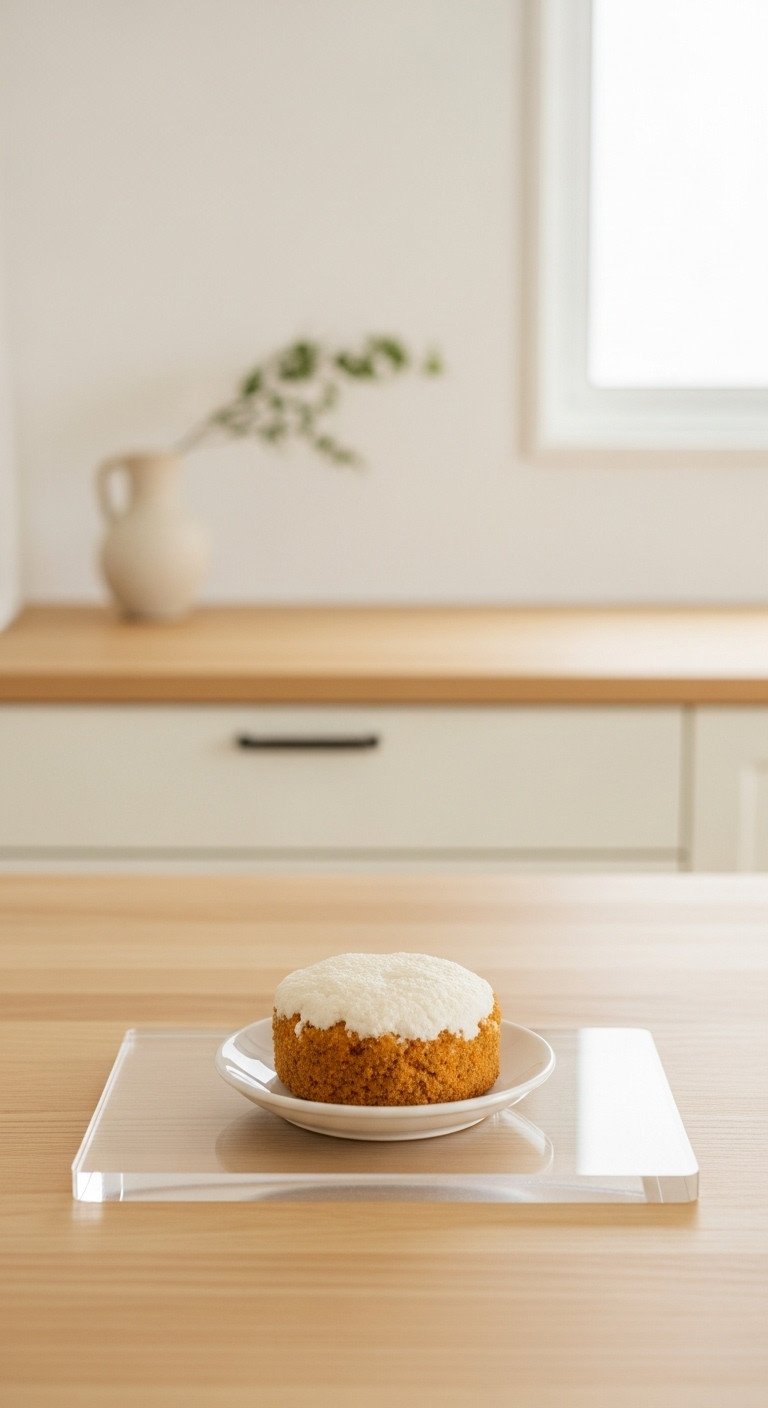
Save this serene kitchen moment to your ‘Minimalist Home’ board!
The most crucial first step in achieving a Japanese kitchen aesthetic is to embrace simplicity by ruthlessly decluttering your surfaces. The core of this design is the “less is more” approach, which means every item must have a purpose and a place. A clear countertop not only provides ample workspace but also instantly creates a sense of calm and openness, which is foundational to the entire aesthetic.
- Materials Needed: Storage bins, drawer organizers, cabinet dividers.
- Step-by-Step Directions:
- Begin by removing everything from your countertops. Sort all items into three distinct piles: Keep, Donate, and Discard. Be honest with yourself about what you truly use.
- For the ‘Keep’ pile, carefully assess what is absolutely essential for daily cooking and food preparation. Everything else must be stored away.
- The ultimate goal is to maintain clear, open work surfaces. To do this effectively, you must maximize every inch of your internal cabinet space.
- Install smart storage solutions like a pull-out cabinet organizer to make the back of your cabinets easily accessible. This prevents items from getting lost and creating clutter in the future.
- Assign a specific, logical home for every single item behind a closed door. This discipline is key to maintaining the minimalist look.
Pro-Tip: “Once a week, take 5 minutes to clear anything that has landed on your countertops. This small habit is the key to maintaining a perpetually serene and uncluttered kitchen.”
2. Utilize Natural Materials: Wood, Stone, and Bamboo
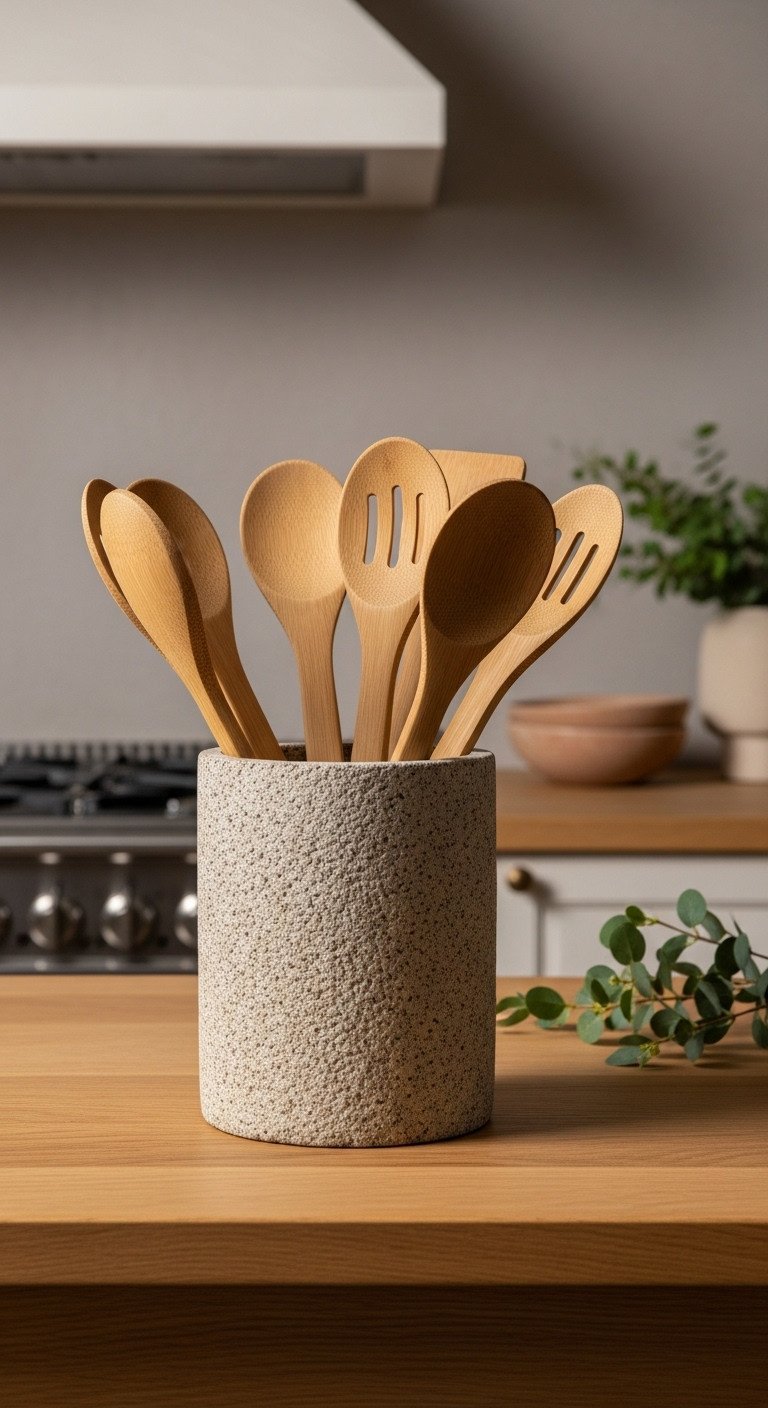
Pin this beautiful texture inspiration for your kitchen refresh!
To create a genuine Japanese aesthetic, you must incorporate natural materials like wood, stone, and bamboo to foster harmony with the environment. This design philosophy prioritizes a connection to nature, and the textures and tones of these organic materials are essential for creating a warm, grounded, and authentic space. You can easily introduce these elements through functional, everyday items.
- Materials Needed: Wood cutting boards, bamboo utensils, stone or ceramic utensil holders, linen dish towels.
- Step-by-Step Directions:
- Start with small, impactful changes. You don’t need to undertake a massive renovation to make a difference.
- Introduce a rich wood tone through functional items. A large acacia or oak cutting board is beautiful enough to be left on display against a backsplash.
- An affordable and instant upgrade is to replace mismatched plastic cooking utensils with a cohesive bamboo kitchen utensil set.
- Store your new utensils in a heavy, natural stone or handmade ceramic crock placed conveniently next to the stove. This adds a touch of wabi-sabi imperfection.
- Swap out synthetic microfiber towels for natural textiles. High-quality linen or cotton dish towels add texture and absorbency.
Lesson Learned: “Light woods like oak or maple create a bright, airy feel, while darker woods like walnut add a layer of sophistication and contrast. Choose one primary wood tone to maintain a cohesive look.”
3. Adopt a Muted Color Palette: Calm and Serene Tones
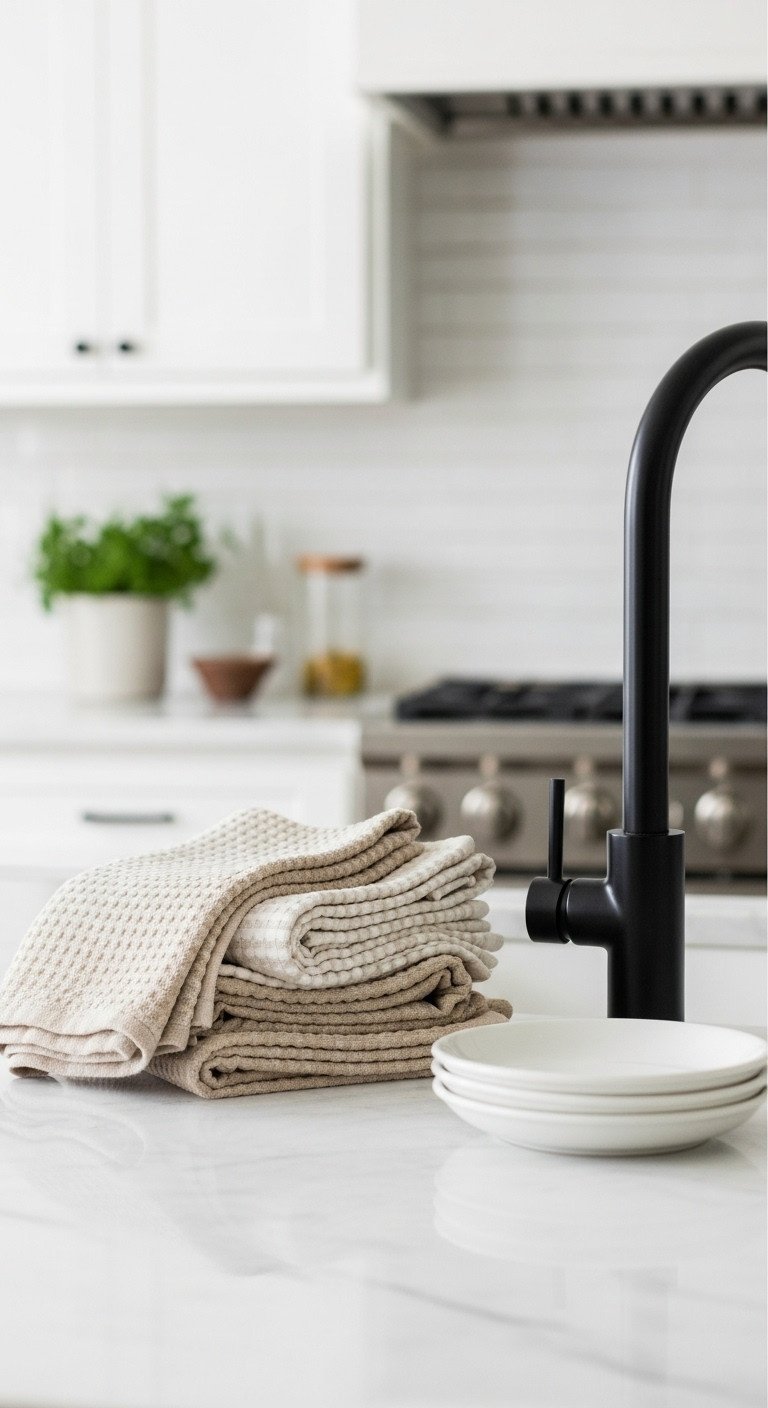
Love this color combo? Save it to your ‘Dream Home’ board!
The beauty of natural materials is best highlighted by a palette of muted and warm neutral tones that create a serene, light-filled atmosphere. This includes colors like sand, beige, cream, ivory, and soft, earthy shades. These light tones are foundational for creating a sense of calm and enhancing the natural light within the space, making it feel more open and tranquil.
- Materials Needed: Paint swatches, neutral-colored textiles, accent hardware.
- Step-by-Step Directions:
- Start by choosing a primary light, neutral color for your walls. A warm white, a soft beige, or a light greige will create the perfect backdrop.
- Select cabinetry in a similar light tone or opt for a natural light wood finish to continue the harmonious palette.
- Introduce varied textures to prevent the neutral space from feeling flat or boring. Highly absorbent and beautifully textured waffle weave kitchen towels in shades of cream, sand, or greige are a perfect and practical addition.
- Use dark colors like black or charcoal very sparingly. These should be reserved for accents to create depth and draw attention to specific elements, such as matte black cabinet pulls, a sleek faucet, or a single statement light fixture.
Pro-Tip: “Before committing to a paint color, get samples and paint large swatches on different walls. See how the color looks in the morning light, afternoon sun, and with your artificial lighting at night.”
4. Optimize Space and Functionality: Every Item Has a Purpose
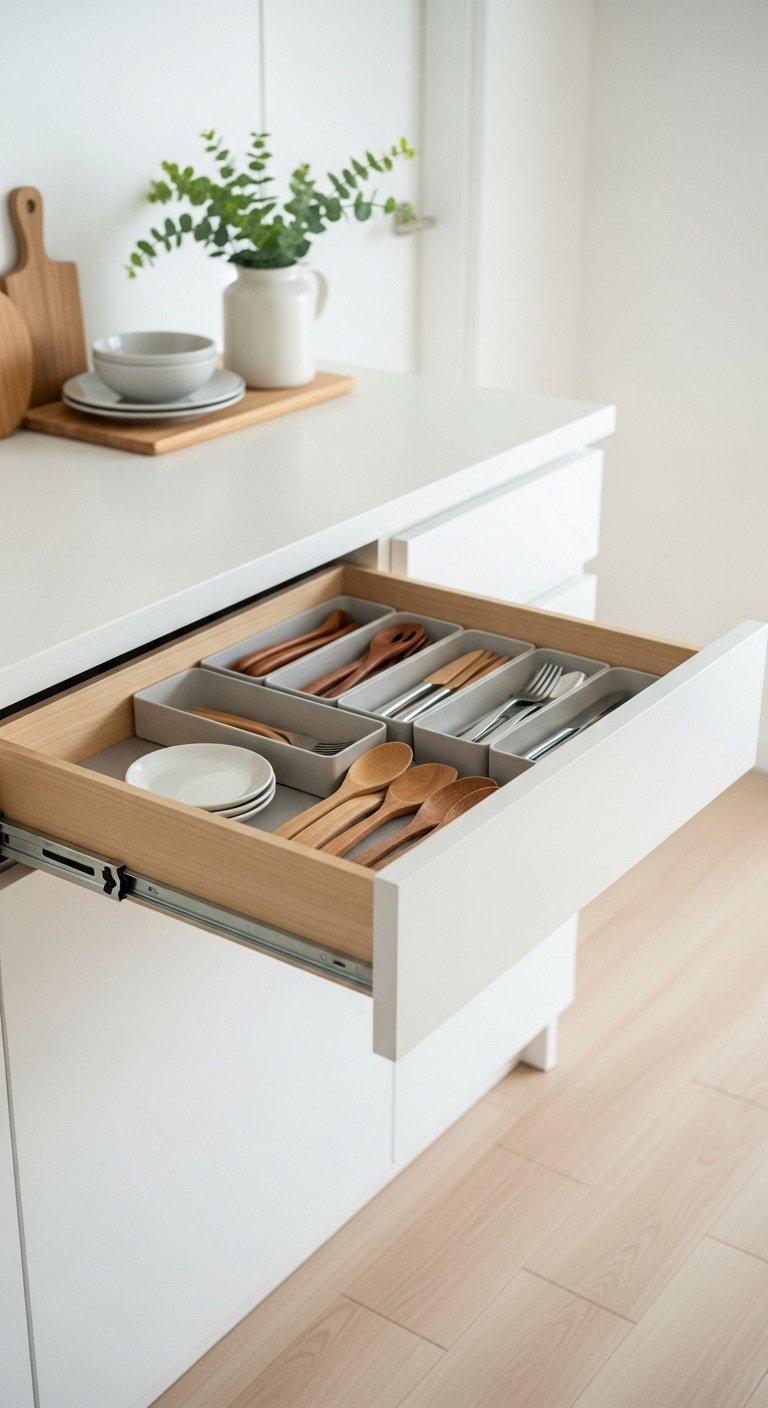
Get inspired to organize! Pin this to your ‘Kitchen Organization’ board.
Japanese kitchen design meticulously organizes space to minimize unnecessary movement and maximize efficiency. This isn’t just about hiding clutter; it’s about creating an ergonomic workflow where everything is logical and comfortable to use. A well-organized kitchen is inherently calming and makes the act of cooking more enjoyable and less stressful.
- Materials Needed: Drawer dividers, pull-out storage systems, cabinet organizers.
- Step-by-Step Directions:
- Begin by analyzing your workflow. Group items together based on their function. For instance, all coffee and tea supplies should be in one cabinet near the water source, and all baking items should be consolidated in another area.
- Tackle your drawers first, as they are often the most chaotic spaces in a kitchen. A little organization here goes a long way.
- Measure the interior of your drawers and invest in a bamboo kitchen drawer divider. Many modern options are expandable to create a custom, built-in look for your utensils, cutlery, and various kitchen gadgets.
- To enhance the sleek, uncluttered look, consider handleless cabinets (with push-to-open mechanisms) or simple, low-profile hardware.
- For deep or hard-to-reach cabinets, install pull-out drawers to ensure you can easily see and access everything you own without having to dig around.
Pro-Tip: “The ‘one-touch’ rule is a game-changer. Organize your kitchen so that you can retrieve or put away any common item with a single motion—opening one door or one drawer.”
5. Foster a Connection to Nature: Bring the Outdoors In
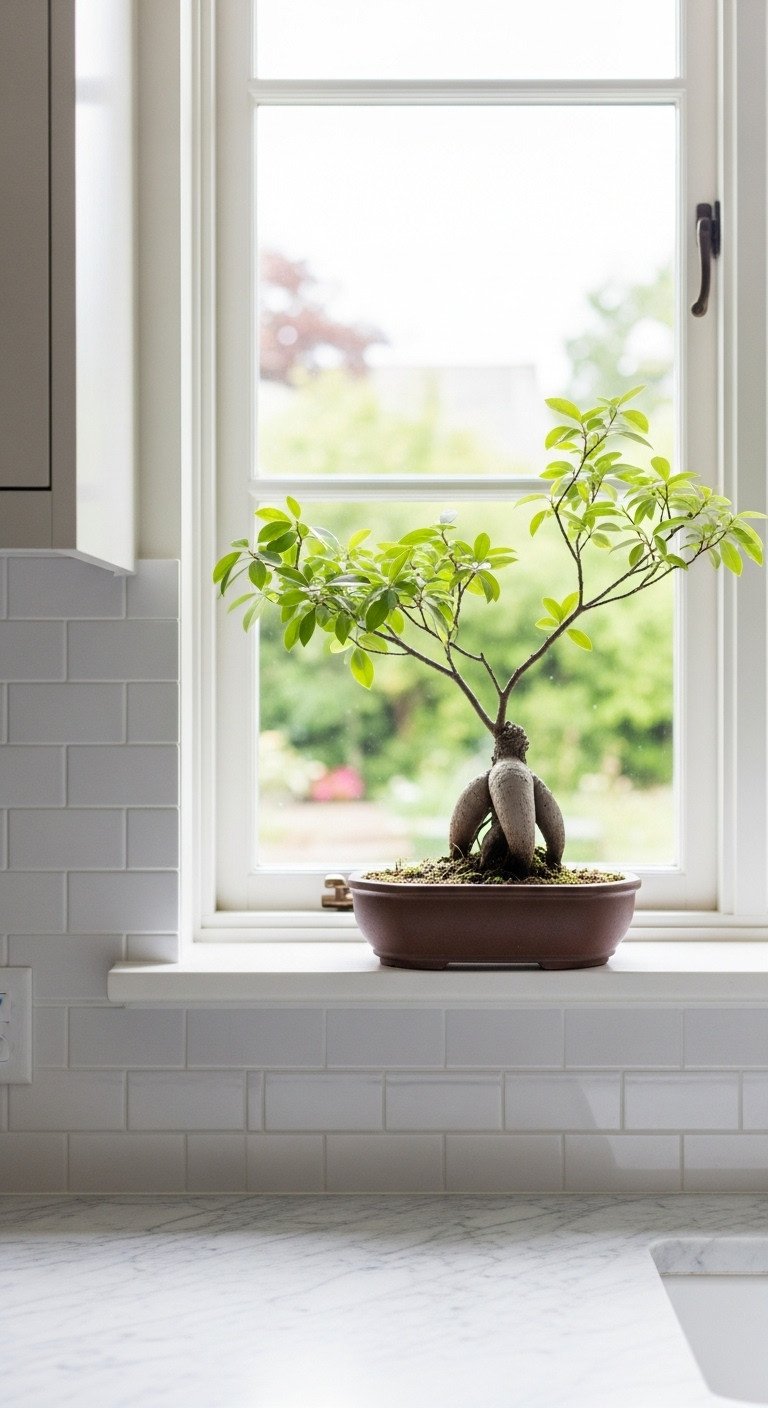
Add some life to your kitchen! Save this green inspiration.
A key feature of Japanese design is blurring the boundaries between the interior and the outdoors by incorporating living, natural elements. Adding greenery or other natural items brings life, freshness, and vitality into the kitchen, providing a beautiful organic contrast to the neutral palette and clean lines. This connection to nature is vital for creating a truly Zen-like atmosphere.
- Materials Needed: Indoor plants, ceramic or stoneware pots, glass vase.
- Step-by-Step Directions:
- First, assess the natural light in your kitchen. Choose plants that will thrive in that specific environment. For lower-light kitchens, snake plants and pothos are very forgiving and easy to care for.
- Select a pot that complements your minimalist aesthetic. A minimalist ceramic planter in a simple shape and a neutral color like white, grey, or sand works perfectly.
- For a distinctly Japanese feel, consider a small bonsai tree for a sunny windowsill. Alternatively, embrace the art of Ikebana by placing a single, interesting-looking branch from your yard in a simple glass vase.
- If you have a kitchen window, keep the coverings light and sheer—or remove them altogether—to maximize natural light and strengthen the connection between your indoor space and the view outside.
Pro-Tip: “Don’t have a green thumb? A simple branch in a vase of water can last for weeks and provides the same sculptural, natural element with zero maintenance. Change the water weekly.”
6. Choose Thoughtful and Intentional Decor
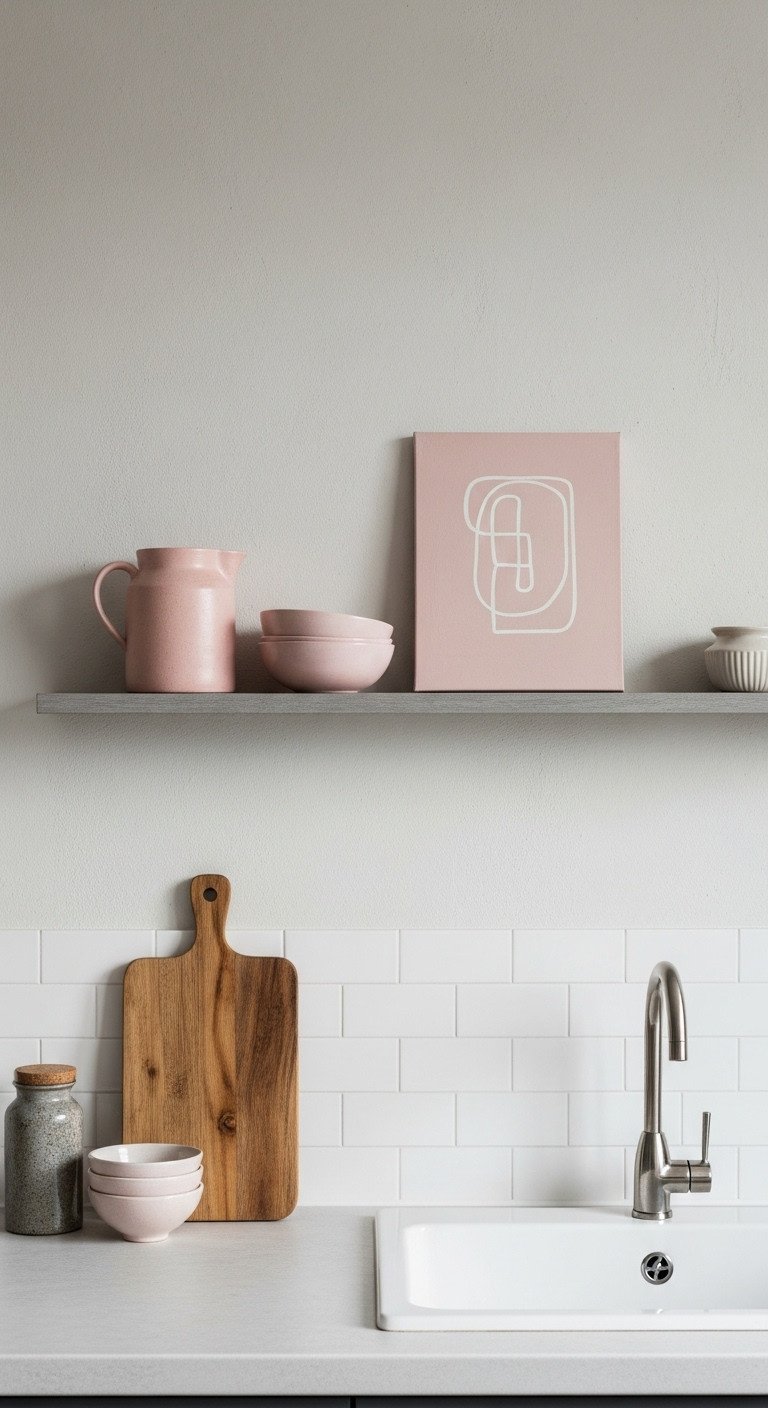
Pin this beautiful shelf styling idea for later!
Given the minimalist focus, decorative elements should be limited, purposeful, and integrate organically into the space. Instead of cluttering the kitchen with purely ornamental items, choose decor that is either functional or holds special meaning. This intentional approach ensures that your space feels personal and curated, not cold or empty.
- Materials Needed: Floating shelves, curated art, ceramic vases or bowls.
- Step-by-Step Directions:
- Strictly follow the ‘one in, one out’ rule for decorative items. If you decide to bring a new piece into your kitchen, something of similar visual weight must be removed.
- Prioritize decor that is both beautiful and functional, such as a set of handmade ceramic bowls that you use for daily meals.
- Embrace the concept of wabi-sabi—finding beauty in imperfection. A textured ceramic vase with a slightly uneven glaze adds more character and soul than a mass-produced, flawless item.
- For wall art, keep it simple. A single piece of calligraphy or a minimalist abstract print in a simple wood frame is more than sufficient to express individuality without overwhelming the space.
- Install one or two floating shelves to display a very small, carefully curated collection of your favorite items, leaving plenty of negative space around them.
Pro-Tip: “The key to intentional decor is to choose pieces that have a story or personal meaning. This infuses your minimalist space with personality and warmth.”
7. Layer Diffused and Natural Lighting
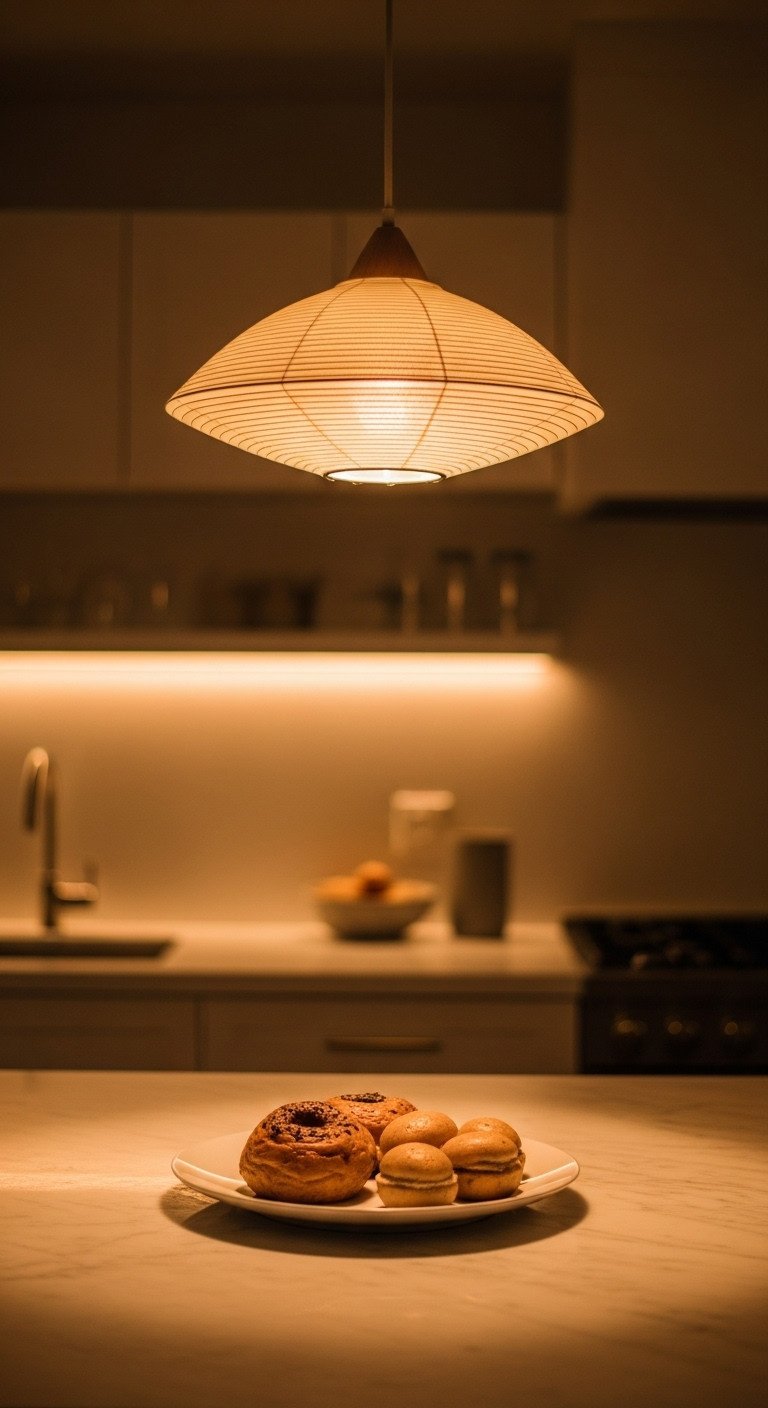
Save this dreamy lighting idea to your ‘Home Ambience’ board!
Lighting is crucial for creating the desired atmosphere, and a layered approach combining ambient, task, and accent lighting is key to achieving a warm and harmonious glow. The goal is soft, diffused light, reminiscent of traditional paper lanterns, which enhances the feeling of coziness and tranquility while ensuring the kitchen remains a fully functional workspace.
- Materials Needed: Pendant light, under-cabinet lighting kit, dimmer switches.
- Step-by-Step Directions:
- Ambient Light: Start with your main overhead lighting. Simple recessed lights or a minimalist track fixture work well for overall illumination. Crucially, install dimmer switches to give you complete control over the mood.
- Task Light: This is non-negotiable for food prep areas. The easiest and most effective way to add this is with an under-cabinet LED light strip. Look for modern kits that are simple to install and offer a warm color temperature.
- Accent Light: This is your statement piece. A beautiful pendant light hung over an island or sink can serve as a focal point. Choose one made from natural materials, like a rice paper lantern or a fixture with wooden elements, to add a soft, diffused glow that is central to the Japanese aesthetic.
Lesson Learned: “Always choose ‘warm white’ (2700K-3000K) bulbs for your kitchen. Cool, blue-toned light can feel sterile and harsh, which is the opposite of the serene atmosphere you want to create.”
8. Emphasize Clean Lines and Sleek Surfaces
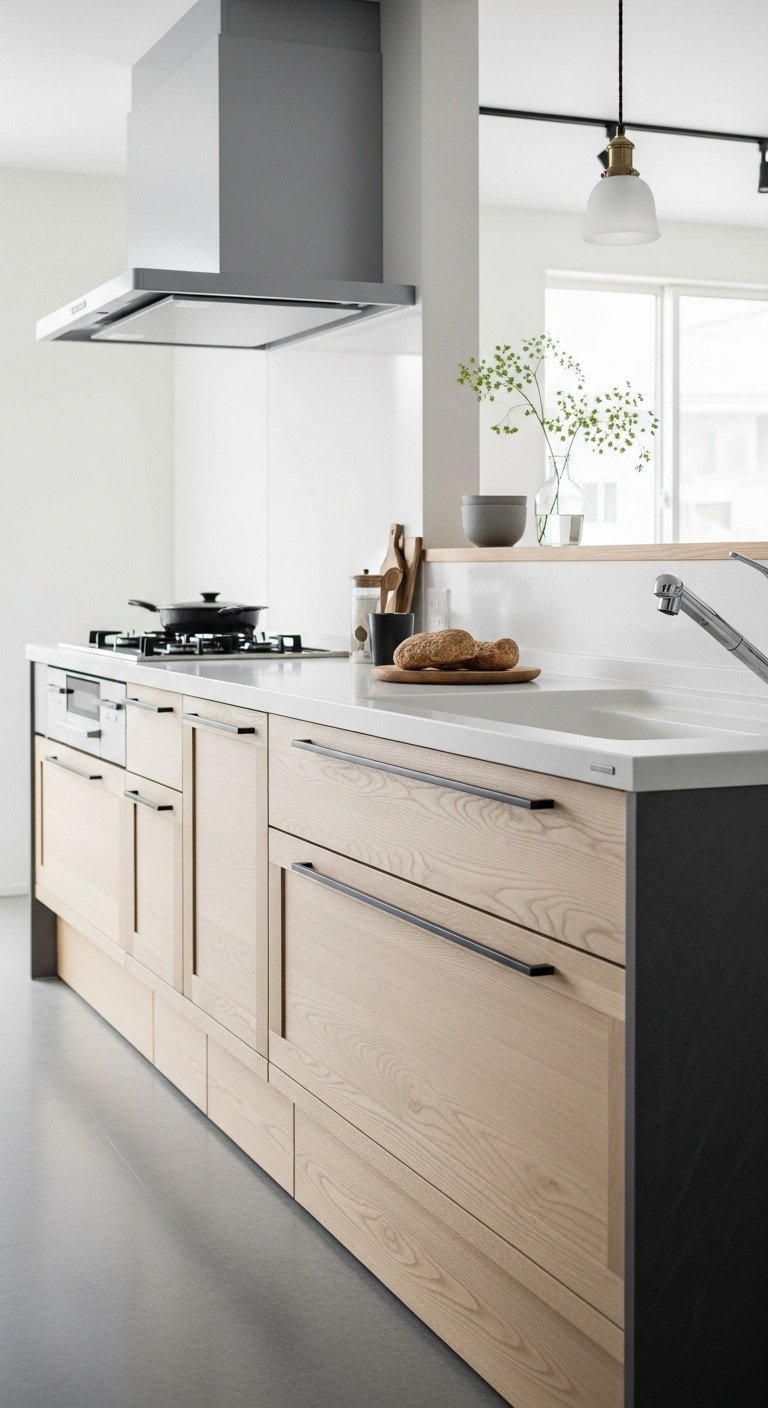
Pin this sleek and modern look for your future kitchen!
Japanese interiors are characterized by straight, simple lines in cabinetry, windows, and furniture, which creates a streamlined and visually calm appearance. Surfaces should be sleek and well-maintained, with appliances and utensils hidden away whenever possible. This unwavering focus on clean lines and uncluttered surfaces is a cornerstone of the minimalist aesthetic.
- Materials Needed: Flat-panel cabinet doors/fronts, integrated hardware, in-cabinet storage solutions.
- Step-by-Step Directions:
- If you are renovating, choose simple, flat-panel cabinet doors without any ornate detailing. If you’re just updating an existing kitchen, you can often save money by replacing only the doors and drawer fronts.
- Opt for integrated J-pull handles or very simple, low-profile bar pulls to maintain a seamless look and avoid visual clutter.
- One of the biggest disruptors of clean lines in a kitchen is often the freestanding trash can. A fantastic solution is a pull-out trash can under the cabinet, which keeps it completely hidden and integrated.
- Use appliance garages or designated cabinets to hide small appliances like toasters, blenders, and coffee makers when they are not in use.
Pro-Tip: “Emphasize horizontal lines to make a space feel wider and more serene. You can do this with long cabinet pulls, floating shelves, or even a tile backsplash with a strong horizontal pattern.”
9. Integrate Japandi Elements for Added Warmth
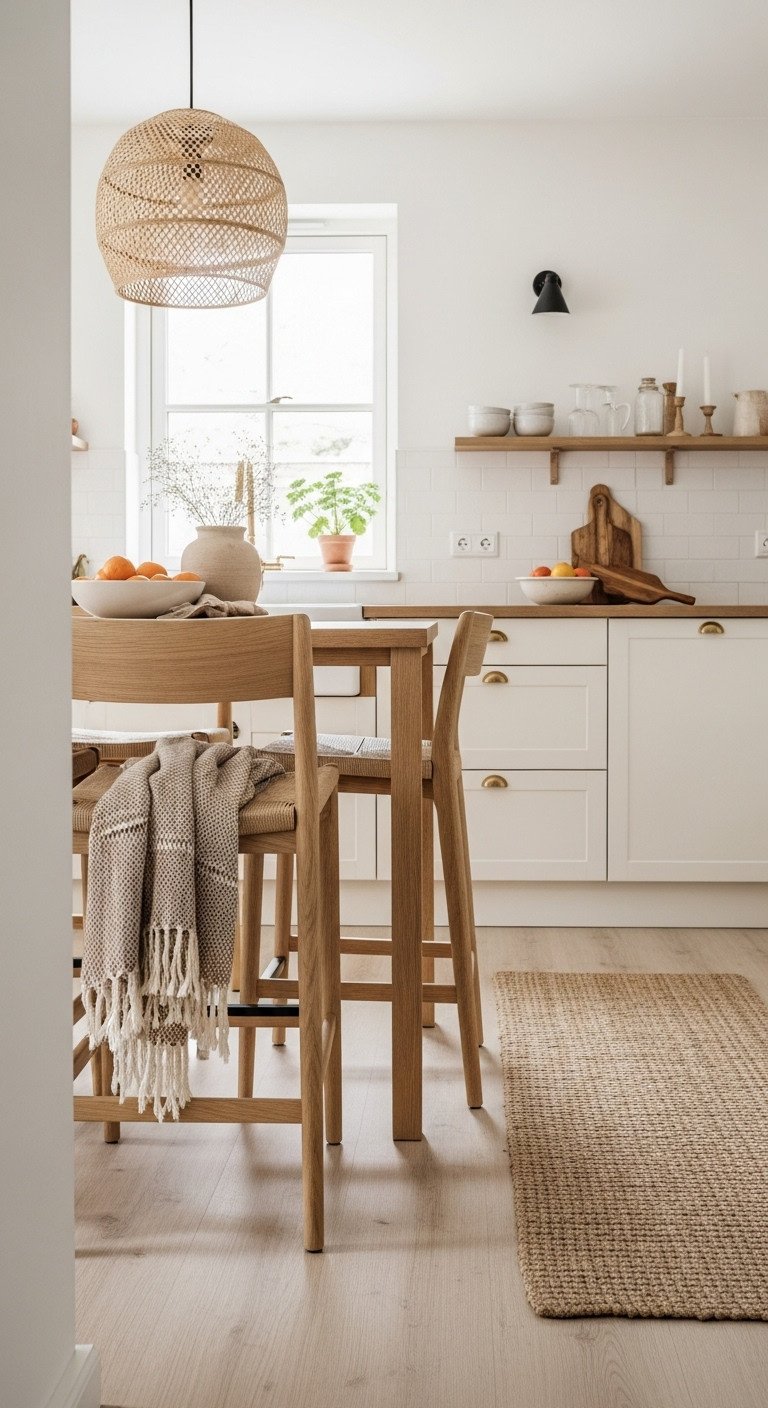
Get the best of both worlds! Save this Japandi idea.
For a modern interpretation, blend the Japanese aesthetic with Scandinavian design to create the popular Japandi style, which adds a layer of warmth and coziness. This fusion combines Japanese elegance and minimalism with Scandinavian functionality and comfort (hygge), resulting in a space that is both serene and inviting.
- Materials Needed: Light wood furniture, natural fiber rugs, cozy textiles.
- Step-by-Step Directions:
- The Japandi style merges the best of both worlds: Japanese minimalism with the cozy warmth of Scandinavian design.
- Start with the Japanese principles of clean lines, a muted palette, and natural materials as your foundational base.
- Introduce classic Scandinavian elements through the use of light-colored woods like oak or ash, especially in seating such as counter stools or a small dining set.
- Add warmth and texture underfoot with a durable natural fiber kitchen runner made from materials like jute or sisal. This adds an organic, cozy, and practical element to the space.
- Incorporate soft textiles to complete the look. A simple wool seat cushion on a wooden stool or a soft cotton throw blanket draped nearby can instantly make the space feel more welcoming.
Lesson Learned: “The key to successful Japandi design is balance. It shouldn’t be too starkly minimalist (Japanese) or too rustically cozy (Scandinavian). The magic is in the middle—a clean space that feels warm and inviting.”
Key Takeaways: Your Quick Guide to Japanese Kitchen Aesthetic
Feeling inspired but need a quick refresher? Here are the most important takeaways to help you on your journey to creating a serene and functional Japanese-inspired kitchen.
* Focus on Simplicity: The number one rule is to keep your countertops as clear as possible. Store all non-essential items out of sight to create a sense of spaciousness and calm.
* Embrace Natural Materials: Actively incorporate wood, stone, and bamboo through items like cutting boards, utensils, and decor to create a strong connection to nature.
* Use a Muted Palette: Stick to warm, neutral colors like beige, white, and sand as your base. This will create a serene atmosphere and make your kitchen feel brighter.
* Prioritize Functionality: Organize your space logically with smart storage solutions like drawer dividers and pull-out organizers to make your kitchen work for you.
* Decorate with Intention: Ditch the clutter. Choose only a few meaningful, beautiful items for display, focusing on pieces that are either functional or hold personal significance.
People Also Ask About Japanese Kitchen Aesthetic
What is a Japanese style kitchen?
A Japanese style kitchen is a design concept focused on minimalism, functionality, and a deep connection to nature. It is characterized by clutter-free surfaces, the use of natural materials like wood and stone, a muted and earthy color palette, and an emphasis on clean, simple lines. The overall goal is to create a space that is harmonious, tranquil, and highly efficient.
How do you design a Japandi kitchen?
To design a Japandi kitchen, you fuse the elegance of Japanese minimalism with the warmth and coziness of Scandinavian design. Start with a Japanese base of clean lines, natural materials, and a neutral palette. Then, introduce Scandinavian elements like light oak wood tones, cozy textiles (jute rugs, linen towels), and a focus on creating a comfortable, inviting atmosphere known as hygge.
How can I apply a Japanese kitchen aesthetic to a small space?
The Japanese aesthetic is perfect for small spaces because it prioritizes minimalism and functionality. To apply it, focus on keeping surfaces completely clear to create a sense of openness. Use a light, neutral color palette to make the space feel brighter and larger. Maximize storage with clever internal organizers like pull-out drawers and drawer dividers to ensure every inch is used efficiently.
Final Thoughts
Creating a Japanese-inspired kitchen is about more than just following a design trend; it’s about cultivating a sense of peace, intention, and mindfulness in the heart of your home. By focusing on simplicity, nature, and functionality, you can craft a space that not only looks beautiful but also supports a calmer, more organized way of living. It’s a journey of transforming your kitchen into a true sanctuary.
What’s the first step you’ll take to bring a little more zen into your kitchen? Let us know in the comments below
Last update on 2025-10-15 at 11:19 / Affiliate links / Images from Amazon Product Advertising API
